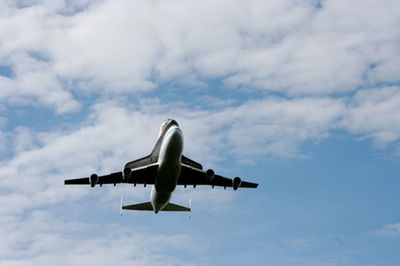Pictures at an exhibitionby Dwayne A. Day
|
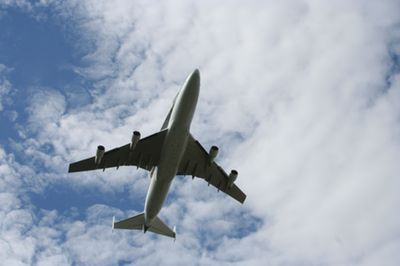 |
For weeks before Discovery’s arrival the Smithsonian advertised the upcoming event, which was actually a four-day celebration of the new shuttle’s arrival. Ads pointed out that the best place to view the flyover of the shuttle on the back of its 747 Shuttle Carrier Aircraft would be the parking lot of the Udvar-Hazy Museum, which is located outside of Washington, DC, near the end of the Dulles International Airport’s longest runway and only a few miles from the airport terminal. Discovery was slated to fly over downtown Washington sometime between 10 and 11 a.m. on the morning of April 17 and the museum’s parking lot was scheduled to open at 8 a.m. “Arrive early,” the radio and television announcers said.
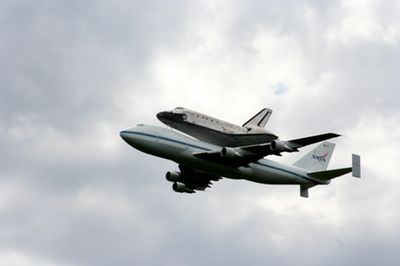 |
I got there at 7:10 a.m. and the gates were already open. The museum is free, but the Smithsonian charges $15 for parking (and there is no shuttle bus or other transportation out there, so you have to pay). The lines were not very long and I was among the first hundred or so cars in the lot. Supposedly the lot can handle 2,000 cars, so the Smithsonian made a lot of money from parking fees, but certainly not enough to cover all the advertising expenses. The sky was a beautiful blue, a perfect day for a flyover.
And then I waited.
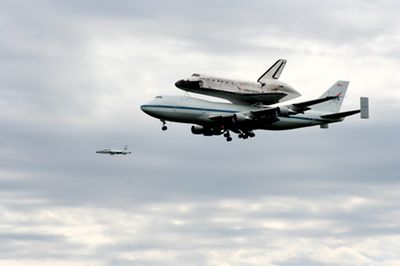 |
If you had walked along the rows of cars in the parking lot during those early morning hours you would have seen hundreds of people sitting behind their steering wheels napping, reading iPads or even (gasp!) newspapers, or listening to the radio. We were the early birds, so anxious to get a spot that we had shown up an hour before the official opening. There were a few families that took the kids out onto the grass and kicked around a soccer ball, and the serious camera buffs were picking out the best observing locations.
Morning radio announcers mentioned the upcoming flyover, usually with a brief discussion of the shuttle’s retirement. But broadcast journalism doesn’t lend itself to complexity, and the announcer on Washington’s top-rated news radio station, WTOP, cheerfully reassured listeners that the shuttle was being replaced by a rocket launching at the end of the month, forgetting to mention that it would be unmanned.
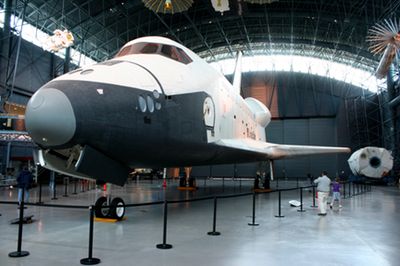 Enterprise on display inside the Udvar-Hazy Center. |
Over the next few hours the parking lot continued to fill and there were still spots around 8:30 or so. Eventually, most of the people migrated to the long walkway in front of the museum, and when the museum doors opened people filed in to use the bathrooms or visit the store. But along with the people came the clouds. The perfect blue sky was soon overcast with a thin layer of silver. They were not low enough to obscure the shuttle, but anybody who knows their way around a camera knows that direct sunlight is best and clouds wash out the light. This was rather disappointing.
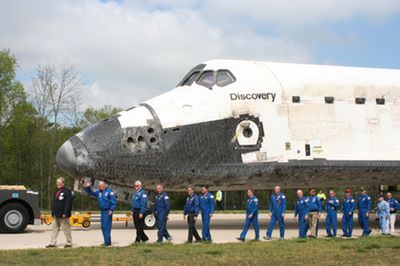 Former Discovery astronauts walk with the orbiter as it is towed into position on Thursday. |
Soon after ten I wandered over to the museum entranceway and talked to a few of the museum employees that I know. They informed me that Discovery was supposed to arrive in about five minutes, apparently early. It was going to fly over the museum, and then head downtown for what some people referred to as a “victory lap.” So I headed back to my car and informed some of the people who were parked around me that the shuttle was arriving soon. We had all heard that the best place to observe the shuttle was the parking lot, so that’s where we were standing.
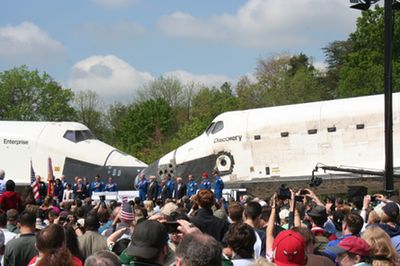 Enterprise and Discovery nose to nose behind the stage. |
That proved to be a mistake. The parking lot was the place to get closest to the shuttle, not the best place to view it. Soon we heard shouts and saw people pointing.
“There it is!” the man standing next to me yelled.
“Where?” I asked, not able to see it.
“There!” he pointed.
“Huh?”
“Right there!” he said, amazed that I could not see it.
A small tree was blocking my view. I took two steps to the left and the 747 and Discovery were flying right at me, at amazingly low altitude. Surprisingly, a 747, even an old model like the one they use to carry around the shuttle, is not very loud.
The plane continued on its way toward the airport. Everybody in the parking lot and along the walkways cheered. Now we knew we would have to wait for it to come back.
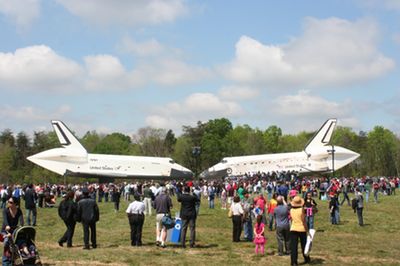 Enterprise and Discovery after the ceremony. |
There were a number of reporters set up at the museum, including a bunch of TV trucks. One of them had its doors open and a large screen television showed Discovery as it flew over downtown Washington. The reporters did not really know where the shuttle was going or when. Apparently the aircraft had flown over the Potomac and National Airport just before 10 am before heading out to Dulles, then headed back downtown. That’s when the people in Washington really got their treat. They went up on building rooftops and out into the street and out on the National Mall and watched as the 747 with its precious cargo circled the city several times. This was no simple flyover; it was a grand tour. The skies were a little clearer over the city, and made for better viewing. If you were outside, you couldn’t miss the plane, and lots of people captured great photographs, including an amusing one that looked as if the planes were perched atop the Washington Monument.
Back at Udvar-Hazy I went into the museum briefly to catch a glimpse of Enterprise. The exhibits surrounding it had been moved out of the way and it looked forlorn and alone, waiting its demotion.
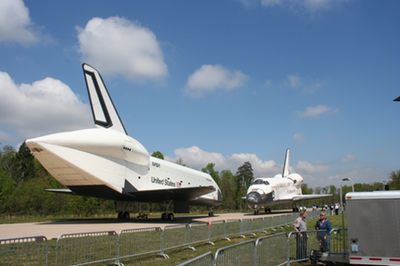 |
Back outside again, I decided to take up a position along the sidewalk, figuring that this would put me at a better spot to view the landing. I was right. When the planes showed up again, they made a beautiful low speed pass against a silvery sky. After they headed off to more cheers, a number of people headed for their cars, figuring that the show was over. But most people had noticed that the 747’s landing gear was not down, so the plane was not landing and would have to come around again. And it did, this time to even louder cheers. Everybody there knew that it was landing for the last time.
Thursday morning I showed up again, this time for the formal ceremony turning Discovery over to the museum. Again we had been told to arrive early, but this time the gates opened at 8 a.m. and it was not nearly as crowded as Tuesday. Enterprise had been rolled out of its hangar about an hour earlier and was parked at the rear of the museum. Discovery was barely visible behind the trees. It was very overcast, almost foggy, but you could tell that it was going to lift as the sun got higher in the sky.
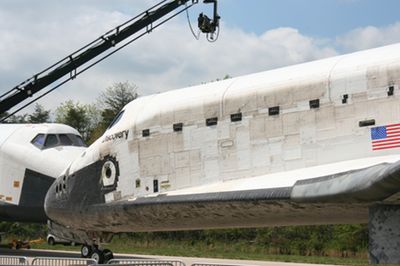 |
The museum was filled with various event tables showcasing different aspects of NASA’s activities. There were tables piled with NASA shuttle posters (all ten years old—one of them summarized “The First 100 Missions,” another the 2000 cockpit upgrade) and people were snatching them up. NASA was also giving out autograph books with photos of astronauts expected to be on hand to sign. To the side of the building was a tent with a mockup of the Orion spacecraft, which had not been mentioned during Tuesday morning’s radio broadcasts. At 11 a.m., the Marine Drum and Bugle Corps played and then Discovery was towed out, with a bunch of her former commanders walking alongside, waving to the crowd. This prompted many people to later refer to the event as a “funeral march.” But the crowd cheered, the sky had mostly cleared, and the temperature was wonderful. It could not have been a better day.
After that came the speeches. And more speeches. And more speeches. At least half a dozen people got up and talked, and there was an official signing as the NASA administrator turned Discovery over to the Smithsonian. I doubt that anybody really cared what was said, and nobody will remember it. John Glenn said that he thought the shuttles were retired too soon, but that water rolled under that bridge a few years ago. What’s done is done.
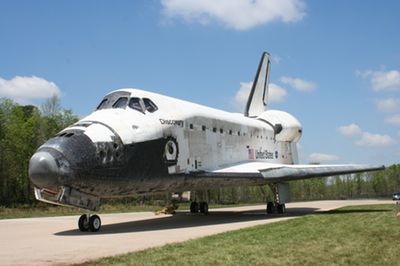 |
After the speeches ended and the Marine band had marched off, the security guards moved the fences and the public could finally get up close to the shuttles, both of them. When I was a kid, I had a plastic space shuttle toy. It didn’t look quite right. The nose was the wrong shape. And it was too… plastic. That’s what the Enterprise looked like. It wasn’t made of the same materials as the shuttles designed for flight and it lacks the detailing and the weathering. Discovery, however, looks real. It is scorched and weathered and its surface looks rougher than you expect. It looks like a spaceship.
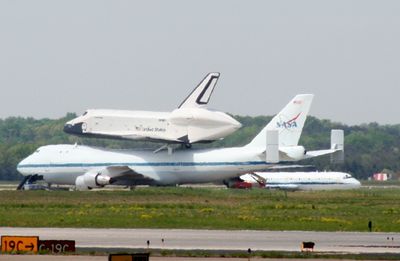 Enterprise seen Saturday, mounted atop the 747 for a flight to New York later this week. |
Nine years ago, when I worked as an investigator on the Columbia Accident Investigation Board, we wrote a report that said that NASA should retire the shuttles when NASA had completed construction of the International Space Station. This was a compromise decision, based upon the Board’s conclusion that although the shuttle was a risky vehicle, the risks could be balanced against the need to fulfill the goal of completing the ISS and upholding America’s international commitments. We expected that this would give NASA time to begin developing a replacement, one that would not repeat the shuttle mistake of not having an escape system. That started the clock ticking to the moment when Discovery would end up in the Smithsonian, with the flybys and the speeches and the ceremonies.
At the end of the week, the political talk shows were filled with chattering gasbags discussing the events. Some used it to throw rocks at their political opponents, some used it to bemoan the decline of American greatness, and some—more than I expected—downplayed the entire thing, saying that it really didn’t matter all that much because there are more important things than human spaceflight. After all, who needs a space program when we have our iPads? All that hot air managed only to convince me that I need to stop watching those shows.
I think I’ll head out to the museum and look at the spaceship some more.
